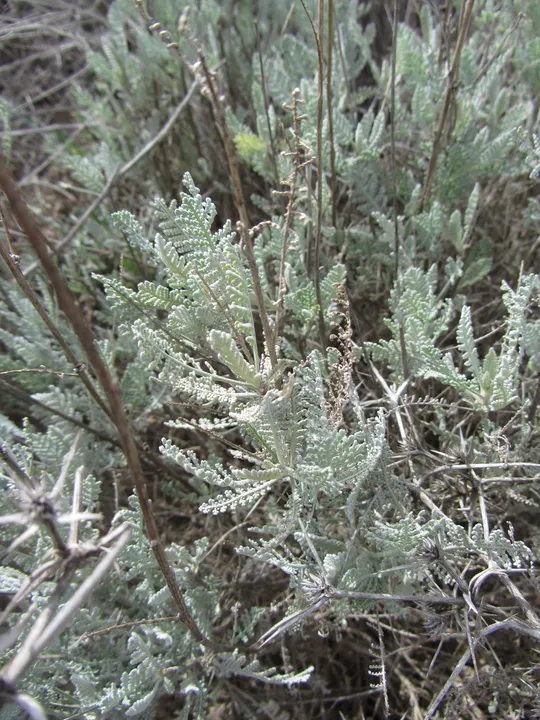Sinai Feverfew
Tanacetum sinaicum



Tanacetum negevensis leaves have a strong odor, useful for sanitization of clothing and wardrobes. The Bedouins use the leaves to heal intestinal diseases, relieve convulsions or for relaxation, making the species vulnerable to massive picking. For now there is no evidence of picking from Israel, Jordan or Sinai.
Tanacetum negevensis in Israel grows in only one region – the Negev Highlands, in a limited area 9 km long and 2-5 km wide, between Wadi Akrav and Wadi Nitsana in the west, and Wadi Eshharim and Wadi Horsha in the east. Other sites in the area include upper Wadi Nitsana, Lots Cisterns, Wadi Elot, Mount Ramon and the Arod Pass.
Soil pockets between rocks, at the foot of rock surfaces, and on stepped limestone cliffs, usually facing north at altitudes above 800 meters.
Tanacetum is a large genus with 150 species, found in the northern part of the temperate Old and New worlds. Its distribution center extends over the Euro-Siberian and Irano-Turanian regions. Some species grow in the East African Mountains. Some species are cultured as ornamental and aromatic plants. Other species are used to produce pharmaceuticals and anti-bacterial substances, and pesticides. In Israel, a different species of Tanacetum was once used to produce a fly and mosquito repellent.
T. sinaticum is a closely related species to T. negevensis. It grows on the mountains of South Sinai and Edom. Another close species, T. densum grows on the high Mount Hermon. Also common on the Hermon is T. aucheri. T. negevensis differs from T. sinaticum in its ligulate flowers on the perimeter of the capitulum and its umbel-like inflorescence, compared to 1-3 interrupted inflorescences on the stem of T. sinaticum.
T. negevensis currently grows in the high steppes, surrounded by typical desert vegetation. Related species do not grow in the desert but on high mountains in the Irano-Turanian region. The species is probably a relict of a rainier period, probably the late Pleistocene, 10,000-15,000 years ago. Many other high mountain steppe plant species grow in the Negev Highlands, which is the only place they grow in Israel. Presumably, the Sinai and Negev regions were formerly rainier, and the high steppe vegetation was dominant. As the climate became dryer the vegetation became limited to mountaintops, most of it became extinct and the minority underwent speciation creating the unique endemic species of the Negev Highlands. T. negevensis underwent such speciation, probably from T. sinaticum, as did other endemic species that grow only in the Negev Highlands – Ferula daninii, Bufonia ramonensis, Amygdalus ramonensis and Origanum ramonense.
The genus Tanacetum is close to the genus Chrysanthemum, and also close to the large genus Anthemis. Tanacetum differs from Anthemis in that it lacks pales on the surface of the capitulum’s receptacle, and therefore cannot retain mature seeds for long. . Moreover, all the Tanacetum species are aromatic, while only some of the Anthemis species produce odors.
• Tanacetum negevensis is known from only ten sites, all of them in one area, 0.5 to 3 km apart.
• All the known T. negevensis populations known to us are small, made up of a single to dozens of individual plants.
• All the T. negevensis populations are included in the Negev Highlands Reserve, but there is extensive military activity in the area.
Two Tanacetum negevensis populations, from two different habitats, rocks (Head of Elot) and rocky slope (Wadi Eshharim), should be selected and monitored. IDF activity in the area should be assessed to ensure that no harm comes to sensitive populations.
Tanacetum negevensis is endemic to Israel. Some of the Tanacetum populations in Edom (in the Aqaba Mountains) are T. negevensis populations. The plants growing on Mount Yalek in northern Sinai are T. negevensis, unlike the other mountains in central and southern Sinai, where T. sinaticum grows.
Tanacetum negevensis is a dwarf shrub, 50 cm high, very aromatic with dissected leaves and a yellow capitulum. In Israel, it grows only in the high Negev Highlands. The species is endemic to Israel and grows only in a few sites, all in one area, which is located in a nature reserve but should be followed because of its biogeographical importance.
Current Occupancy Map
| 1000 squre meter pixel | 5000 squre meter pixel | 10000 squre meter pixel | |
|---|---|---|---|
| number of observations | 0 | 0 | 0 |
| in total pixels | 0 | 0 | 0 |
| Family | Asteraceae |
| Classification | On the extremely rare species list |
| Ecosystem | Desert Mountains |
| Chorotype | Endemic (Saharo-Arab) |
| Conservation Site | Head of Wadi Elot and Wadi Eshharim |
| Rarity |
1
1
6
|
|---|---|
| Vulnerability |
0
0
4
|
| Attractiveness |
0
0
4
|
| Endemism |
0
1
4
|
| Red number |
1
1.5
10
|
| Peripherality | 0 |
| IUCN category | DD EW EX LC CR EN VU NT |
| Threat Definition according to the red book | Least concern |
 Based on:
Based on:






